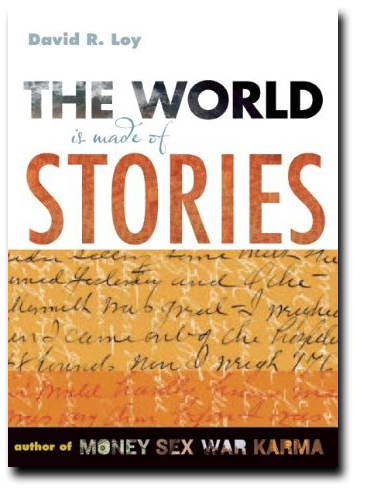
In the midst of reading this book I went to see Christopher Nolan’s movie, “Inception”. “Inception” is all about dreams, about entering other people’s dreams and, in some circumstances, not knowing when one is in a dream or is in ‘reality’. It’s a fairly silly movie with lots of things blowing up and gun fights and car chases. All in all, disappointing, given the high praise the movie has received from critics and the audiences. But, as with many “high concept” movies (think The Matrix here), it does have a few interesting points here and there. Dreams within dreams within dreams until eventually we get lost and don’t know how to get back to what we believe is reality. And what’s to say that this reality is not just another dream, another dream within a dream?
 David Loy’s book, The Word is Made of Stories, is not about dreams but about stories, and stories within stories. Loy sees us as creating stories and then living out those stories, usually without being aware that we are living a self-created, many-layered story. Where is the reality? From a Buddhist perspective (and Loy is a Buddhist), the Big Story is not to be deluded by the stories but to recognize that clinging to a story is what gets us into trouble. At the center of this understanding is shunyata, emptiness, “a heuristic device to free us from wherever we are stuck.” (p 44) Loy goes to some lengths to point out that although some see enlightenment as the end of story-creating, we can also find a path by living more flexibly in the world with all its stories --- instead of drowning in the sea of samsara, we learn how to surf, to dance upon the waves.
David Loy’s book, The Word is Made of Stories, is not about dreams but about stories, and stories within stories. Loy sees us as creating stories and then living out those stories, usually without being aware that we are living a self-created, many-layered story. Where is the reality? From a Buddhist perspective (and Loy is a Buddhist), the Big Story is not to be deluded by the stories but to recognize that clinging to a story is what gets us into trouble. At the center of this understanding is shunyata, emptiness, “a heuristic device to free us from wherever we are stuck.” (p 44) Loy goes to some lengths to point out that although some see enlightenment as the end of story-creating, we can also find a path by living more flexibly in the world with all its stories --- instead of drowning in the sea of samsara, we learn how to surf, to dance upon the waves.
Loy uses what could be called mini-essays broken up by an extensive collection of quotations from a eclectic variety of sources ranging from philosophers, Buddhists, and poets to scientists, literary critics, journalists, and writers. Sources ancient and modern have been tapped to fertilize the ground upon which Loy ploughs his furrows. This is not really a collection of essays but a collection of ideas, of questions, of explorations, often expressed in a single line, or a short paragraph. As with all books of this type, there is something for everyone here and there is always something that makes you wince with its triteness: “When I get a grip on the world, the world gets a grip on me.” (p 91) I must confess I found Loy’s use of the noun ‘story’ as a verb to be most irritating: “To understand is to story.” (p 4) But these are minor criticisms and each reader can determine for themselves where they stand as this is what I call a ‘dipping book’, a book you can pick up and open to any page and dip in and out of at will. There is a narrative structure of sorts but not one that you the reader have to follow. You can create your own story of the book. As Loy says, “Stories do not have sharp edges. They never begin at the beginning.” (p 10)
In the film “Inception”, the main character Cobb introduces the woman Ariadne to the world of shared dreams, in this case, his own. The two are sitting at an outdoor café enjoying a coffee and Cobb asks the woman how she got there. Ariadne doesn’t know how or even when she arrived at the café. Cobb points out that we never know when a dream begins. We are always in the midst of a dream but never at the beginning. Likewise, stories never begin; they are just there, ready for us to participate and develop further as we wish. The music is already there; the musician just writes it down. As Stravinsky said about The Rite of Spring, “I heard, and I wrote what I heard.” (p 100) David Loy heard a story and wrote it down and now we can listen to his story and see if it resonates with our own. I think it just may.
Further Reading: some other David Loy writings
Second Buddha : Nagarjuna - Buddhism's Greatest Philosopher
Letter on the September 11, 2001 attacks on America
On the Nonduality of Good and Evil: Buddhist Reflections on the New Holy War
Transcendence East and West
Zen at War book review